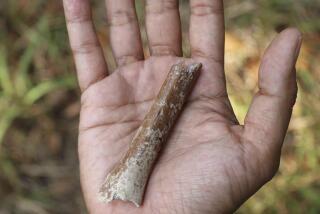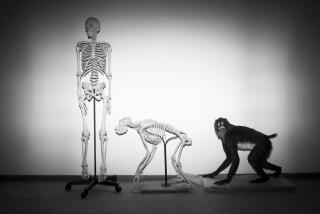Jawbone of early human puts evolution in a whole new light
Has climate change made us who we are today? A broken and fossilized jawbone found poking up amid sediment in an East African hill is rewriting a significant chapter of human evolution — and adding weight to the argument that a hot, parched climate guided the development of our ancestors.
In a pair of papers published Wednesday in the journal Science, researchers described the discovery of a 2.8-million-year-old jawbone in Ethiopia’s Afar regional state. Studded with five intact teeth, the mandible reveals that our genus, Homo, appeared almost half a million years earlier than previously believed, after branching off from the more apelike Australopithecus genus that included the likes of “Lucy,” perhaps the most famous set of skeletal remains.
The significance of this discovery, according to some researchers, is that it firmly fixes the origins of Homo in East Africa and fits the hypothesis that climate change drove key developments in a variety of mammals, including our early forebears.
When Lucy roamed Ethiopia roughly 3.2 million years ago, the region enjoyed long rainy seasons that supported the growth of many trees and a wide variety of vegetation, according to researchers.
By the time of Homo’s first established appearance in the Horn of Africa, however, things had become much drier and the landscape had transformed into a vast, treeless expanse of grasslands with a few rivers and lakes — a scene very similar to today’s Serengeti plains or Kalahari.
It was an unforgiving climate when it came to survival.
But the hallmark of the genus that includes Homo sapiens is resourcefulness. Larger brains, the ability to fashion stone tools, and teeth suited to chewing a variety of foods would have given our early ancestors the flexibility to live in an inflexible environment, researchers say.
“This early Homo could live in this fairly extreme habitat and apparently Lucy’s species could not,” said Kaye Reed, an Arizona State University paleontologist who worked on both studies.
The record of early Homo evolution in Africa is notoriously sparse. Erosion, tectonic shifting and other factors have left very few remains for scientists to study.
As a result, even the fragmentary jaw found at the Ledi-Geraru site is cause for celebration.
“The time period between 2 and 3 million years ago is one of the least well understood in human origin studies,” said coauthor William Kimbel, director of Arizona State’s Institute of Human Origins.
Researchers were unable to determine the fossil’s age directly. Instead, they used radiation dating to estimate the vintage of a layer of volcanic ash and crystals roughly 30 feet below the fossil, which is known as LD 350-1.
Oddly enough, some of the natural forces that make it so difficult to find archaeological specimens of a certain age make it relatively easy to determine changes in Earth’s ancient climate.
Soil that is flushed out to sea by erosion, or blown off the land by monsoon winds, will drift to the ocean floor and form vast layers of undisturbed sediment. These layers provide chemical clues to periods of dryness or abundant vegetation, researchers say.
Scientists have used these layers to assemble a “robust” record of ancient climate and hypothesized that it probably fueled human evolution. But the key fossil evidence to demonstrate the link remained elusive, said Peter deMenocal, a paleoclimatologist at Columbia University who was not involved in either study.
“It’s as if we were putting together this gigantic, multidimensional puzzle,” DeMenocal said. “There was a big missing piece we couldn’t find anywhere in the box. Now, we’ve magically found it.”
The newly discovered jaw dates to a period of tumultuous climate change that included the arrival of the first ice age in the Northern Hemisphere, he said.
“The very first of these glacial cycles appeared right at 2.8 million years ago,” DeMenocal said. “That’s one of the reasons this is a very important date. There’s a lot going on in the world at this time.”
The jaw’s discovery, as well as an analysis of a mandible from Tanzania that was described Wednesday in the journal Nature, already has scientists reordering the branches of the human ancestral tree.
It is now clear that three separate species of Homo existed between 2.1 and 1.6 million years ago, although not all simultaneously: H. habilis, H. rudolfensis and H. erectus.
Researchers have not yet determined the species of the creature that left behind the jaw discovered at Ledi-Geraru. They are still digging for additional pieces of skeleton that will help them make a decision.
Fred Spoor, a professor of evolutionary anatomy at University College London who worked on the Nature study, said the jaw fragment probably belonged to a species that was a common ancestor of Homo habilis and another Ethiopian fossil that was previously thought to be Homo habilis, but now must be recategorized.
But scientists already know enough to say with certainty that East Africa is the birthplace of Homo, according to paleoanthropologist Donald Johanson, one of Lucy’s discoverers.
In recent years, a competing hypothesis held that our genus may have originated in South Africa. Paleoanthropologist Lee Berger of the University of the Witwatersrand in Johannesburg, South Africa, had argued that a number of skeletons of Australopithecus sediba, which date back as far as 1.9 million years, display a variety of features that may have given rise to the genus Homo.
“Sediba is no longer a contender,” Johanson said.
Johanson, who was not involved in the new studies, said he had examined the jawbone and had no doubts about its age or genus, or that the region in which its owner lived had seen great changes in climate since the days of Lucy.
“Was climate change the motivator for evolutionary change in early humans?” Johanson said. “That’s still open to discussion, but I am sure it played some sort of role.”
Follow me on Twitter @montemorin and “like” Los Angeles Times Science & Health on Facebook.







